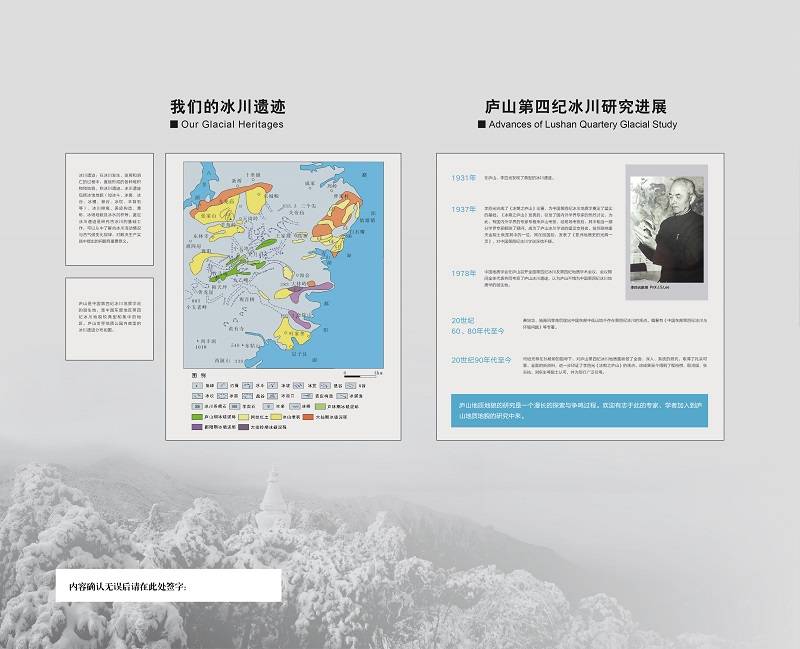3.1 Discovery of Quaternary Glaciers in China
Evidences of glacial stages and ice flows emerging in the early Quaternary Period have all been
known existing in the regions such as Northwest Europe, Americas and Oceania, but not any
glacial traces were found in East Asia and other relevant regions until the early years of twentieth
century. It was Professor J.S. Lee, renowned scientist, that found the presence of Quarternary glaciers in China for the first time, and he was the founder of the Quaternary glacial geology of China, as well.
3.1.2 In 1921, J.S. Lee discovered drift boulders and striated pebbles at the eastern foot of the
Tai Hang Mountains and in the DaTong Basin, Shan Xi Province. In 1922, he issued a paper entitled
Traces of Neoid Glaciation in North China, demonstrating that Quaternary glacial epoch had
taken place in the regions around North China. In the summer of 1931, J.S. Lee, while mak-
ing field investigations, found large numbers of moraines in Lushan and its adjacent area, some were found having been spread as far as to the banks of the Po Yang Lake. In the next summer J.S. Lee, made further prospecting and surveying in Lushan area, obtaining more abundant data and information, and subsequently they also saw the moraines of the same kind in the vicinity of DongLiu, An Hui Province.
3.1.3 When making an academic report in the 10th annual meeting of the Geological Society of
China held in 1933, J.S. Lee presented a paper on The Quaternary Glaciations of the Yangtze
River Basin. Most of the noted geologists present took a sceptical attitude toward the fact that
there should have been Quaternary glaciers in China. In the Spring of 1934, foreign scholars came
investigating in Lushan area and many of them became surprised by the special and unique
landforms occurring in this area. However, some people still held opposite opinions. Later on, J.S. Lee and Yu De Yuan, discovered U- valleys, landforms of glacial erosion and drift boulders at Tian Mu, Zhe Jiang Province. In 1936, J.S. Lee,found a contact plane between gompholite and limestone of Mid-Carboniferous Epoch, on the limestone side of which glacial striae were conspicuously visible in Bai Shi Zui on the bank of the Po Yang Lake.

3.1.4 In May, 1936, J.S. Lee discovered striae of glaciation at both U- valley near Ci Guang
Temple and at Li Ma Peak in Huangshan, An Hui Province, which aroused great interest by
scholars both at home and abroad. Professor Weisman, a German, who taught in the then Central
University, acknowledged the conclusion drawn by J.S. Lee after he personally observed them.
.
3.1.5 After he returned from Lushan, J.S. Lee began to write a paper called Quaternary Glaciations in the Lushan Area, which was completed in 1937, but it was not simultaneously put into publication in both English and Chinese until 1947 because of the War of Resistance against Japanese Invasion. Having come this far, the presence of phenomena of glacial stages in China was definitely
established, and J.S. Lee also became the first Chinese scientist who revealed the true face of
Lushan in terms of geologic science. Quaternary Glaciations in the Lushan Area deals, in a systematical way, with the heritages of Quaternary glaciers in Lushan area and established way of divisions of glacial stages and interglacial stages, and in the meanwhile contrasts with those of Alpine region in Europe, laying a foundation for the establishment of Quaternary Glacial Geology in China.
3.1.6 Based on the discoveries gained at Long En Temple, Mo Shi Kou, Ba Da Chu, He ye Shan,etc. in West Hill Area of Bei Jing, J.S. Lee issued a paper The Quaternary Glacial Traces in Beijing’s West Hill Area and Questions concerning Glacial Age in China in 1960. Mr Narivtsin, academician of the ex-Soviet Union Academy of Science, went observing glacial pavement on bed
rock at Long En Temple, and after that he changed his original view that there was no Quaternary glaciers in China. When he returned home, Mr Narivtsin wrote an article called A Brilliant Page in Asian Geological History, in which he “firmly believed” that there had existed Quaternary glaciers in China, including, those in Lushan area.

3.2 Foundation Site and Typical Areas for Research Quaternary Glaciers in China
The paper Quaternary Glaciations in the Lushan Area written by J.S. Lee not only syste- matically dealt with the glacial Heritages of Quaternary glaciations in a holistical manner in terms of glacial geomorphological landscapes, glacial accumulations up to outwash sediments, but also expounded the whole process of glaciation in Lushan area, with glacial stages and interglacial stages divided and thus laying a good foundation made for the establishment of glacial geology of Quaternary Period in China. Thereafter, relevant research and scientific institutions, productive establishments conducted systematic researches into the traces of Quaternary glaciations in the Lushan area, employing dozens of up-to-date techniques and new approaches in conjunction with multi-disciplinary collaboration, producing over 170 volumes (pieces) monographs and papers.
In 1978, the Geological Society of China held “The National Academic Symposium on the Quar- ternary Glaciers and Quaternary Geology of China” in Lushan. Participants of the symposium, after making field trips to investigate traces of Quaternary glaciers, were unanimous in holding the opinion that Lushan area was a typical one where Quaternary glaciers had been developed, and hence a foundation site fit for Quaternary glaciers research.
Lushan is one of the typical developed areas of Quaternary glaciers in China .Now there are more than one hundred localities important glacial heritages found in Lushan, which intactly recorded the whole processes of accumulation of ice and snow, formation of glaciers, glacial movement and glacial erosion, transportation and deposition, revealing paleoclimate alteration in East China and geological features in Quaternary Period. During the 1930’s, J.S. Lee assigned Lushan to glacial substage of Quaternary Glacial Period based on his research work in the division of scarlet-colored drift clay which had been rather tightly cemented, of red brownish-colored drift clay which had been loosely cemented and of yellow brownish-colored drift clay moraines. Ice streams of Po Yang Galaciation went down as far as onto Xie Hill in the Po Yang Lake; terminal moraines and debris of Da Gu Glaciation stopped moving in the neighbourhood of Da Gu on the bank of the Po Yang Lake; the latest was Lushan Glaciation, whose frontal part had stopped moving in an area in Lushan about 800 m above sea level. After J.S.Lee, Li Chun Yu and Wang Heng Sheng went together investigating Alpine glaciers in 1935, they confirmed that Lushan Quaternary glaciers should be assigned to Alpine glacial type, typical “intermediate latitude, intermediate mountainous, oceanic, piedmont glaciers.”

3.3 Phases of Quaternary Glacial Period in Lushan .
By integrating the existing research fruits, we may draw to a conclusion that there occurred four glacial stages in Lushan during the Quaternary Glacial Period: Da Pai Ling Glacial Stage dated back to 3 – 2.5 Ma, Po Yang Glacial Stage dated back to 1.8 – 1.6 Ma, Da Gu Glacial Stage dated back to 1.1 – 0.9 Ma and Lushan Glacial Stage dated back to 0.4 – 0.2 Ma, and most probably Lu Lin Glacial Stage should also be added, which could be correlated in general with those existing at the northern foot of the Mid-Alpine, North Europe, North America, etc.









